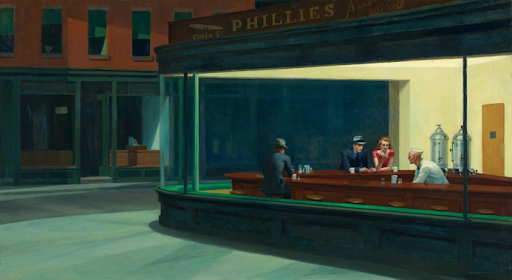“If you could say it in words, there would be no reason to paint.” – Edward Hopper
The painting above, ‘Nighthawks’, was painted by American artist Edward Hopper. As he completed this painting, Hopper was dealing with the unique sensation of being an accomplished artist while struggling with depression. His poor and abusive relationship with his wife and the second world war were the culprits. Regardless, this legendary painting was completed in 1942, not long after the Pearl Harbour bombing: an event which terrified millions of Americans. In a period already so monotone and dark, the ‘Nighthawks’ was a visual representation of what millions felt in bustling New York: loneliness.
For context, Edward Hopper is somewhat of a celebrity when it comes to the art world. Whilst the usual New Yorker has no idea who Hopper is and is clueless when the ‘Nighthawks’ is mentioned, to art critics and painters, Hopper is an idol. Like the usual artist, Hopper was firstly unknown and relatively small. He didn’t sell a piece of work until 1913 when one of his oil paintings finally fetched $250. However, in 2018, his work ‘Chop Suey’ sold for a shocking 91.9 million dollars. His art was also appreciated towards the end of his career when his work was influenced by American cinema. Many modern movies use frames from a ‘Hopper’. Even ‘The Batman’, which garnered an astonishing sum of 770.8 Million USD at the box office, uses a scene from Hopper’s most well-known and appreciated painting: The Nighthawks.
In the Nighthawks, a diner can be seen with four mysterious figures inside it. If I were to describe the painting without showing you it, you wouldn’t imagine much. But, when the painting is seen, it is different from what would be imagined. It is ominous. It is empty. It is even fair to say, unnerving. Many speculate that the building was influenced by a street in Greenwich village, yet not exactly copied. Most Likely, Hopper used inspiration from numerous buildings to achieve the diner in the artwork. However, nothing about the cafe looks old. If not for the old-fashioned figures, the painting would look fairly modern. The sense of timelessness and unfamiliarity shows the painting to be a depiction of an isolated and abandoned city and not a scene from 1940s New York.
The figures in the painting, according to Hopper’s wife, were modelled by the artist and his spouse. Josephine Hopper quotes, “E. (referring to Edward) posed for the two men in a mirror and I for the girl. He was about a month and a half working on it.” From Josephine’s diary, we also learn what is meant by the title ‘Nighthawks’. The word nighthawk informally refers to one that stays up at night, however, Jo (Josephine’s nickname) mentions that the artist was thinking of something else when he named his masterpiece. Her notes say that the title refers to the gentleman next to the woman, with a beak-like nose.
It is important to note that Jo’s diaries and a few of Hopper’s notes and sketches show that the couple was extremely unhappy. Their relationship was toxic and abusive. Yet, they stayed together. A sign of the miserable marriage is clear in a majority of Hopper’s paintings. Interestingly, all of the male and female figures in all of his paintings seem disconnected, weary and silent. Though they sit close together, the red-haired femme and the hawk-like man seem uninterested, sharing almost no chemistry. Perhaps, it is the still and awkward atmosphere of this painting that makes it so eerie.
From the strange fluorescent lights to the mysterious green and the unwelcoming crowd, the Nighthawk is an unknown masterpiece. This painting was bought in 1942, immediately after it was painted, by the Art Institute of Chicago for an underwhelming sum of 3,000 USD. It is still displayed in the museum and is visited by many frequently. The Nighthawks is accredited to perfectly displaying the emotion felt by many distraught Americans during the war. It also perfectly captures a snapshot of loneliness and how alien it may feel. Who would ever guess that bustling, vibrant New York with such colourful trends and famous faces had such a lonely side?
Sources:
https://www.artnews.com/feature/edward-hopper-who-is-he-most-famous-works-1202682710/
https://www.artic.edu/artworks/111628/Nighthawkss
https://rhodescontemporaryart.com/news/346-the-story-behind-edward-hoppers-Nighthawkss/


